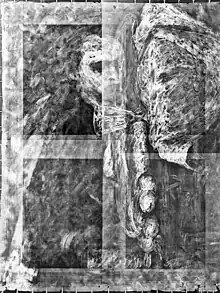Still Life with Bread and Eggs
Still Life with Bread and Eggs (Le pain et les oeufs) is an 1865 painting by Paul Cézanne in the collection of the Cincinnati Art Museum. It is considered one of Cézanne's most important early still life paintings. In 2022 it was discovered it had been painted over an earlier portrait, possibly a self-portrait.
 Le pain et les oeufs | |
| Artist | Paul Cézanne |
|---|---|
| Year | 1865 |
| Medium | Oil on canvas |
| Movement | Realist |
| Subject | Still life |
| Dimensions | 59.1 cm × 76.2 cm (1.94 ft × 2.50 ft) |
| Location | Cincinnati Art Museum |
Description
The painting, which depicts a baguette, eggs, and red onions with a pewter tankard, a knife and a wine glass on a cloth-draped tabletop, is one of Cézanne's few dated paintings. The painting is from his "dark period" and is done in a realist style, as were many of his early works before he moved into an impressionist style and then post-impressionist.[1][2] In 1865 it was rejected for an exhibit at the Salon.[3] According to Le Monde it is "one of Paul Cézanne's most important early still lifes".[3]
Discovery of earlier portrait
In 2022 a portrait was discovered beneath the still life when the museum's chief conservator, Serena Urry, removing the painting from an exhibit in which it had been included and examining it for potential maintenance requirements, noticed unusual patterns in the cracking and "on a hunch" had it x-rayed.[4]
Description of earlier portrait

The portrait is rotated a quarter turn beneath the still life.[1] The sitter is rendered in 3/4 view.[2]
Because Cézanne dated few paintings, it is believed to be the earliest firmly dated portrait by the artist.[5][6] Museum curators believe it is likely a self-portrait; if so it may also be one of the earliest depictions of the artist, who was in his 20s the year he painted the still life.[4] Cézanne completed dozens of self-portraits, but almost all were in pencil and were created after the 1860s.[1]
The museum as of December of 2022 planned further investigation, including consulting with Cézanne experts and further imaging work such as multispectral imaging and x-ray fluorescence spectroscopy.[1] The still life was returned to exhibit alongside an image of the portrait.[1] It has been in the Cincinnati Art Museum's collection since 1955, when Mary E. Johnston donated it to the museum.[5]
See also
References
- Holland, Oscar (2022-12-15). "For almost 160 years, a Cézanne painting had a secret hidden beneath its surface". CNN. Retrieved 2023-07-20.
- Sutton, Benjamin (2022-12-16). "'We went from having two Cézannes to three': x-ray of still life painting reveals hidden portrait". The Art Newspaper. Retrieved 2023-07-20.
- Azimi, Roxana (2022-12-21). "La découverte d'un portrait sous un tableau de Cézanne met les spécialistes en émoi". Le Monde (in French). Retrieved 2023-07-20.
- Feldman, Ella (19 December 2022). "For 158 Years, a Cézanne Portrait Hid Behind a Still Life of Bread and Eggs". Smithsonian Magazine. Retrieved 2023-07-20.
- "Cincinnati Art Museum discovers hidden work under a Cézanne painting in its collection". Cincinnati Art Museum. 15 December 2022. Retrieved 2023-07-20.
- Richmond, Nathaniel (2022-12-15). "Cincinnati Art Museum uncovers secret 150-year-old Cézanne painting". WKRC-TV. Retrieved 2023-07-20.